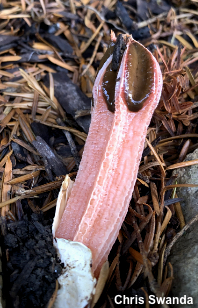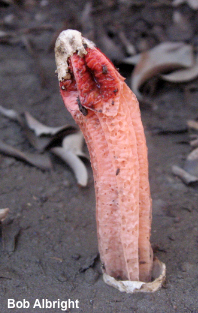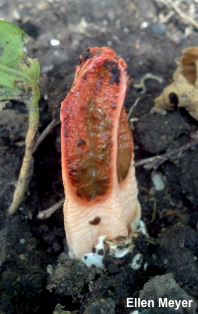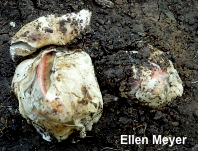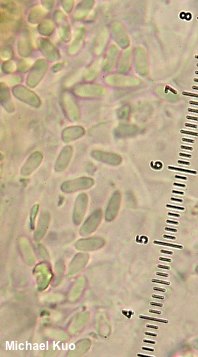| Major Groups > Stinkhorns > Lysurus mokusin |

|
Lysurus mokusin [ Basidiomycota > Phallales > Lysuraceae > Lysurus . . . ] by Michael Kuo Lysurus mokusin is very cool, and very stinky. Like all stinkhorns it reproduces by presenting the world with a malodorous, spore-saturated gooey material that attracts insects, who then disperse the spores. And like other species of Lysurus it features a well-developed stem and a head structure that is separated into arms, "claws," or a lattice. But the stem of Lysurus mokusin is not round in cross-section; instead, it is squared off into flat sides with angled, rib-like corners. And the "claws" in its head structure are also distinctive; they usually stay joined at the tips, and the spore goo covers their inner surfaces from top to bottom. This combination of features will serve to separate Lysurus mokusin from other, similar species. Thanks to Bob Albright, Ellen Meyer, and Chris Swanda for collecting, documenting, and preserving Lysurus mokusin for study; their collections are deposited in The Herbarium of Michael Kuo. Description: Ecology: Saprobic; growing alone or gregariously, usually in urban habitats (lawns, landscaping, gardens, and so on); fairly widely distributed, but most common in California and Australia; also ranging from the Great Plains to Texas; in eastern North America appearing below a line from roughly Maryland to St. Louis; also reported from Africa, Asia, and southern Europe; summer, or, in warm climates, year round. The illustrated and described collections are from California, Kansas, and Oklahoma. Fruiting Body: Initially a whitish "egg" up to 2 cm wide and 3 cm high; emerging to form a mushroom with a stem and a head. Stem 2–7 cm long; 0.5–1.5 cm thick; usually pale orange or pink, but sometimes whitish; 4- to 6-sided, with longitudinal ribs and, between them, sunken surfaces that are flattened or slightly concave; more or less equal; pocketed, with the pockets arranged in vertical lines; spongy and soft; hollow; base encased in a white volva that is attached to white rhizoids. Head 1–2 cm high; 1–2 cm thick; formed by extension of the stem's ribs, creating a fusiform or egg-shaped, lantern-like structure in which the ribs are separated by concave surfaces covered with malodorous, dark brown spore slime; arms joined at the tips, creating a point—but occasionally becoming separated in old age; hollow; dark to pale orange underneath the spore slime. Microscopic Features: Spores 3–4.5 x 1–1.5 µm; cylindric; smooth; hyaline to yellowish in KOH; inamyloid; not cyanophilic. Context sphaerocysts 10–30 µm; subglobose to ellipsoid; walls 1 µm thick; hyaline in KOH. Volval tissue composed of hyphae 2–7 µm wide, frequently septate, clamped at septa, smooth, thin-walled, hyaline in KOH. REFERENCES: (Linnaeus, 1782) Fries, 1823. (Lloyd, 1909; Nonis, 1979; Dring, 1980; Smith, Smith & Weber, 1981; Arora, 1986; McKnight & McKnight, 1987; Hosaka et al., 2006; Nonis, 2007; Trierveiler-Pereira et al., 2014; Desjardin, Wood & Stevens, 2015.) Herb. Kuo 03201201, 06111301, 06251901. Herb. CSU CLO 4998. This site contains no information about the edibility or toxicity of mushrooms. |
© MushroomExpert.Com |
|
Cite this page as: Kuo, M. (2019, September). Lysurus mokusin. Retrieved from the MushroomExpert.Com Web site: http://www.mushroomexpert.com/lysurus_mokusin.html |
